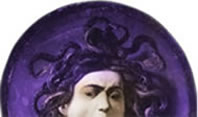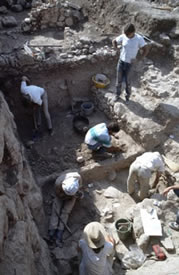About The Lukeion Project
How we got started
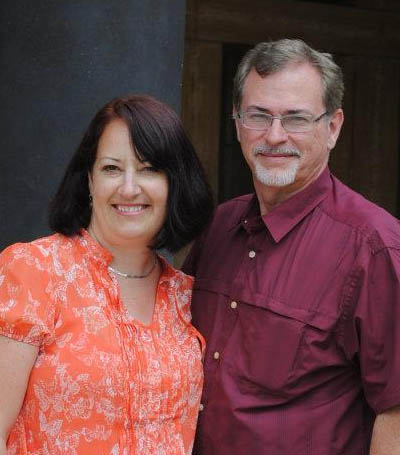 The Lukeion Project was the brain child of Regan and Amy Barr, two Classical archaeologists who have traveled extensively and excavated at Classical sites in Jordan, Greece and Turkey. After hurricane Katrina forced a job change in 2005, the Barrs combined their years of education in Latin, Greek, history, Classical literature and archaeology with their skills in online training and graphic design. As home educators of three, they recognized the real need for accessible, challenging Classical education. Current technology provides them live online classrooms and everything else they need to deliver high quality, challenging instruction to everyone with interest and a broad band internet connection.
The Lukeion Project was the brain child of Regan and Amy Barr, two Classical archaeologists who have traveled extensively and excavated at Classical sites in Jordan, Greece and Turkey. After hurricane Katrina forced a job change in 2005, the Barrs combined their years of education in Latin, Greek, history, Classical literature and archaeology with their skills in online training and graphic design. As home educators of three, they recognized the real need for accessible, challenging Classical education. Current technology provides them live online classrooms and everything else they need to deliver high quality, challenging instruction to everyone with interest and a broad band internet connection.
Pioneers in online education
When the Barrs first opened as series of workshops online early in 2006, they didn't know what to expect. At the time, very few educators were providing live education online. They were met with skepticism by some, curiosity by others. Here is a portion of a local newspaper article written about The Lukeion Project in our first year.
“Dust-free antiquity” is not just a catchy trademark for students learning their Greek and Roman history at The Lukeion Project.
Gathering in the online classroom before class, they “chat” with students from across the country, watch a review of their last session, or work through an online review game. Once class starts their computer screen lights up with images of classical Greece or Rome, and the voices they hear coming from their computer speakers belong to real, live archaeologists who hated history in high school. That won’t happen to these students. They ask questions, vote in class polls, and respond to the instructor either privately or by drawing or typing on the “screen” for all to see. This is not just another online tutorial. But Regan and Amy Barr are not typical home educators.
“We got our hands dirty so you don’t have to,” joke the instructors. They spent 10 years traveling, researching, and excavating in the Mediterranean region. As they pursued advanced degrees in Classics, New Testament, Latin, and Classical Archaeology, they also built a wealth of unique experiences, impressive resumes, and a library of proprietary images that they bring with them into the online classroom.
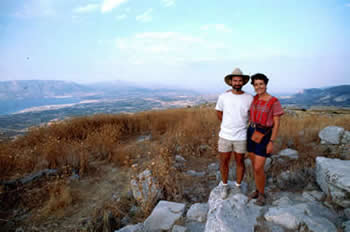 The Barrs’ teaching experience includes the University of Cincinnati, Cincinnati Christian University, Miami University (Oxford, OH), and The Ohio State University. They’ve been speakers for the Cincinnati Art Museum Lecture Series, the North American Christian Convention, the Institute for Learning in Retirement, and they were participants in a Congress on Cypriot Archaeology held in Göteborg, Sweden.
The Barrs’ teaching experience includes the University of Cincinnati, Cincinnati Christian University, Miami University (Oxford, OH), and The Ohio State University. They’ve been speakers for the Cincinnati Art Museum Lecture Series, the North American Christian Convention, the Institute for Learning in Retirement, and they were participants in a Congress on Cypriot Archaeology held in Göteborg, Sweden.
They’ve been speaking at home school conferences on the east coast spreading their infectious enthusiasm for the classical world. “We actually became engaged on the island of Crete after an excavation season in Greece,” said Regan. “For years we immersed ourselves in the literature, lands, art and artifacts of the Greeks and Romans. We even immersed ourselves in their dirt,” he chuckles. The Barrs are true “dirt archaeologists,” who excavated in Jordan (a Byzantine site), Greece (a Bronze Age Mycenaean citadel), and Turkey, at the legendary site of Homer’s Trojan War. Their three seasons at Troy culminated in articles for the journal Studia Troica, devoted entirely to studies of the Trojan world.
The Barrs, who have home schooled their own three children from the beginning, launched The Lukeion Project in 2005. One of the many benefits of home schooling is the ability to seek out innovative learning venues and expert instruction for children. “We’ll teach our children Latin, History, and Mythology. We’ll find someone else to teach them Physics or Economics. It’s what co-ops have done for years, sharing expertise to take our children farther than we can by ourselves. We just share our expertise online.”
So why are The Lukeion Project classes live? “Well, it’s not because it’s lucrative or easy,” laughs Amy. “It’s easier to write a workbook, make some copies, and sell it. But our classes are unique because our students interact with people experienced in the Mediterranean world who are passionate about the material. You can’t communicate that through a workbook. And we’re inter-disciplinary – we do history, archaeology and literature together, which is a more interesting and well-rounded way to learn about the past. Just doing literature, for example, gives you the perspective of the upper classes, but to know how the other 99% lived, you have to ask an archaeologist. ”
“CDs and online tutorials don’t do what we want, either,” says Regan, “because our students ask questions that canned presentations can’t anticipate. And students love the classroom interaction that learning alone can’t give you. Also, many people are surprised to learn that our understanding of the ancient world is changing all the time. We still don’t have all the facts, and one important discovery can radically change our understanding of something we’ve 'known' for years. Archaeology is constantly surprising us. We share those new finds in our classes and we send them out in our email newsletter.”
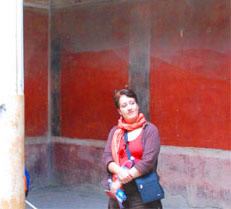 Besides the online classroom experience, students also have access to a class web page that includes review games and activities, as well as diagnostic quizzes and exams. Today’s technologically savvy students enjoy the reinforcement that comes through fun, online games. The Lukeion Project offers two types of classes. Full Semester (16-week) classes are considered high-school level “college-prep” courses and require research papers as well as a mid-term and final.
Besides the online classroom experience, students also have access to a class web page that includes review games and activities, as well as diagnostic quizzes and exams. Today’s technologically savvy students enjoy the reinforcement that comes through fun, online games. The Lukeion Project offers two types of classes. Full Semester (16-week) classes are considered high-school level “college-prep” courses and require research papers as well as a mid-term and final.
So where does the name come from? “The‘Lukeion’ was the school in Athens established by Aristotle, in which he encouraged personal investigation and a broad array of research tools. It was a school without walls, since he often wandered through Athens with his students gathering around as he walked and lectured. We thought his approach to education and the mobile metaphor fit an online learning environment,” says Amy. “Now we’re looking for more over-educated experts on Egypt, Mesopotamia, and the rest of history to join our teaching staff. And the great part is, it doesn’t matter where they live! They teach from home.”
More information about our instructors
Regan Barr
 Known as Mr. Barr to his students, Regan is an archaeologist, educator, home school dad, and co-founder of The Lukeion Project. Regan began his education with a B.A. in Christian Ministries before heading to Cincinnati Christian University, where he received his M.Div. in New Testament and minored in Ancient Near Eastern studies. His parents’ graduation gift of a trip to Greece, Jordan and Israel ignited his love for the ancient world, which still drives The Lukeion Project today. Regan spent the next 10 summers traveling and excavating in the Mediterranean and Europe while pursuing an M.A. and Ph.D. in Classical Archaeology at the University of Cincinnati. He’s excavated at the Decapolis city of Abila in Jordan, the Bronze Age Mycenaean citadel of Midea in Greece, and the venerable site of Homer’s Troy in Turkey.
Known as Mr. Barr to his students, Regan is an archaeologist, educator, home school dad, and co-founder of The Lukeion Project. Regan began his education with a B.A. in Christian Ministries before heading to Cincinnati Christian University, where he received his M.Div. in New Testament and minored in Ancient Near Eastern studies. His parents’ graduation gift of a trip to Greece, Jordan and Israel ignited his love for the ancient world, which still drives The Lukeion Project today. Regan spent the next 10 summers traveling and excavating in the Mediterranean and Europe while pursuing an M.A. and Ph.D. in Classical Archaeology at the University of Cincinnati. He’s excavated at the Decapolis city of Abila in Jordan, the Bronze Age Mycenaean citadel of Midea in Greece, and the venerable site of Homer’s Troy in Turkey.
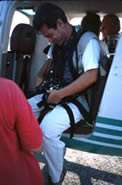 His publication of the Greek and Hellenistic oil lamps from Troy was the first formal publication on this topic in over a century of excavation at the site. Regan has spoken in such diverse settings as the Cincinnati Art Museum lecture series, the North American Christian Convention, the Cincinnati Women’s Club, schools and home school co-ops across Ohio, and was also a participant in a Congress on Cypriot archaeology held in Göteborg, Sweden. Regan’s teaching experience includes classes at Cincinnati Christian University, the University of Cincinnati, and the Institute for Learning in Retirement.
His publication of the Greek and Hellenistic oil lamps from Troy was the first formal publication on this topic in over a century of excavation at the site. Regan has spoken in such diverse settings as the Cincinnati Art Museum lecture series, the North American Christian Convention, the Cincinnati Women’s Club, schools and home school co-ops across Ohio, and was also a participant in a Congress on Cypriot archaeology held in Göteborg, Sweden. Regan’s teaching experience includes classes at Cincinnati Christian University, the University of Cincinnati, and the Institute for Learning in Retirement.
Regan and his wife, Amy, live near Nashville, TN, where they home school their 2 sons (their eldest has now graduated).
Degrees
- B.A. Ministries (Midwest Christian College – now Ozark Christian College)
- M.Div. New Testament Studies, minor in Ancient Near Eastern Studies (Cincinnati Christian University)
- M.A. Classical Archaeology (University of Cincinnati)
- M.A. Thesis: “Honors for Late Hellenistic Civic Benefactors in Western Asia Minor”
- Doctoral Work – completed coursework and doctoral exams for Ph.D. in Classical Archaeology at the University of Cincinnati
Teaching
- Ten year full-time teaching veteran at The Lukeion Project
- Frequent lecturer at home school conferences in the United States
- Graduate Teaching Assistant for numerous classes at the University of Cincinnati, including Classical Mythology, Introduction to Classical Civilization; Introduction to Greek Archaeology, Introduction to Roman Archaeology;
- Graduate Teaching Assistant and guest lecturer for numerous classes at Cincinnati Christian University including Advanced Greek, Historical Geography of the Bible, The Synoptic Gospels, etc.
- Various lectures for the Institute for Learning in Retirement (ILR) at the University of Cincinnati
- Instructor for “Greek and Latin Elements of Medical Terminology” at the University of Cincinnati
Professional publications
- "Which Greek Should You Study?" The Greenhouse Report, May/June 2012 vol. 30 #5
- “Greek and Hellenistic Lamps from Ilion,” Studia Troica, Band 6 (1996) pp. 159-200.
Amy Barr
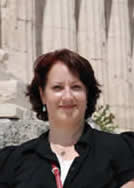 Known by her students as Mrs. Barr, Amy is an archaeologist, educator, home school mom, and co-founder of The Lukeion Project. During the summer between her freshman and sophomore years at Cincinnati Christian University she excavated at the Decapolis city of Abila in Jordan, but returned to find that her degree program in Ancient Near Eastern Studies had been canceled. She transferred to Miami University (Oxford, OH) to complete a B.A. in Classics and received her M.A. in Latin from The Ohio State University, where she was the head teaching assistant for a Mythology class of over 900 students. She returned to Miami University to begin her doctoral work in Ancient History, but soon transferred to the University of Cincinnati to pursue a Ph.D. in Classical Archaeology.
Known by her students as Mrs. Barr, Amy is an archaeologist, educator, home school mom, and co-founder of The Lukeion Project. During the summer between her freshman and sophomore years at Cincinnati Christian University she excavated at the Decapolis city of Abila in Jordan, but returned to find that her degree program in Ancient Near Eastern Studies had been canceled. She transferred to Miami University (Oxford, OH) to complete a B.A. in Classics and received her M.A. in Latin from The Ohio State University, where she was the head teaching assistant for a Mythology class of over 900 students. She returned to Miami University to begin her doctoral work in Ancient History, but soon transferred to the University of Cincinnati to pursue a Ph.D. in Classical Archaeology.
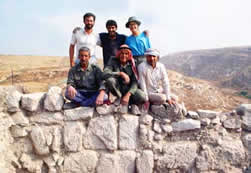 In addition to her work at Abila, where she contributed to excavation reports, she has also excavated at the Mycenaean citadel of Midea in Greece and the venerable site of Homer’s Troy in Turkey. Her publication of “horse and rider plaques” from the sanctuary at Troy linked this unique votive art form to the hero cult that grew in popularity after the campaigns of Alexander the Great and the founding of the Hellenistic monarchies. Amy helped develop a classical Mythology class that emphasized writing skills at Miami University, has been a workshop speaker at the North American Christian Convention, and was a participant in a Congress on Cypriot archaeology held in Göteborg, Sweden.
In addition to her work at Abila, where she contributed to excavation reports, she has also excavated at the Mycenaean citadel of Midea in Greece and the venerable site of Homer’s Troy in Turkey. Her publication of “horse and rider plaques” from the sanctuary at Troy linked this unique votive art form to the hero cult that grew in popularity after the campaigns of Alexander the Great and the founding of the Hellenistic monarchies. Amy helped develop a classical Mythology class that emphasized writing skills at Miami University, has been a workshop speaker at the North American Christian Convention, and was a participant in a Congress on Cypriot archaeology held in Göteborg, Sweden.
Amy’s teaching experience includes Miami University, The Ohio State University, the University of Cincinnati, and the Institute for Learning in Retirement. Amy and her husband, Regan, live in Holly Springs, NC, where they home school their 3 children.
Degrees
- B.A. Classics (Miami University, Oxford, OH - Magna Cum Laude); B.A. Honors Thesis: “Egyptianizing in Ancient Rome”
- M.A. Latin (The Ohio State University); Masters Paper: “Animal Imagery in Virgil’s Aeneid”
- Doctoral Work – completed coursework for Ph.D. in Ancient History at Miami University and Classical Archaeology at the University of Cincinnati
Teaching
- Ten year full-time teaching veteran at The Lukeion Project
- Frequent lecturer at home school conferences in the United States
- Instructor for Latin 101 at the Ohio State University and at the University of Cincinnati.
- Graduate teaching assistant for Classical Mythology at the Ohio State University
- Instructor for Classical Mythology at Miami University, Oxford, OH
- Instructor for Latin 101 at The University of Cincinnati
- Long-time tutor in Latin and Mythology
- 16-year veteran home educator of three
Professional publications
- Classical Homeschooler columnist with The Old Schoolhouse
- "The Enduring Legacy of Ancient Greek Drama," p. 54-55 TOS, Jan. 2012
- "Be Sure to Fail a Little Every Day" TOS, p. 55-56, Feb. 2012
- "Totally Epic," p. 61-62 TOS, Mar. 2012
- "Invest in Inspiration with Travel Abroad," TOS, April 2012
- "Modern Technology Brings the Ancient World Home," TOS, May 2012
- "Latin & Greek Are Still Fundamental Areas of Study," p. 60-61 TOS, July 2012
- "Drawing up Great Grammar, TOS August, 2012
- "History is Stranger than Fiction," TOS, September, 2012
- "Don't Forget What the Ancient Found," TOS, October 2012
- "Muses, Music and Memorization," TOS, November, 2012
- "Three Things Your Teen Must Practice for Best College Success," December, 2012
- "Homeschool Expeditions Abroad," TOS, January 2013
- "Three Myths About Classical Mythology," TOS, February 2013
- "Time is a Labyrinth, Not a Line," TOS, April 2013
- The Power and Peril of Being Gifted," TOS, May 2013
- "Horse And Rider Plaques At Ilion. A Preliminary Study Of The Hellenistic Hero Cult In Asia Minor,” Studia Troica, Band 6 (1996) pp. 133-58.
- excavation reports filed in the Near East Archaeology Society Bulletin
- Published archaeological illustrator, articles on Abila, Midea and Troy
Sue Fisher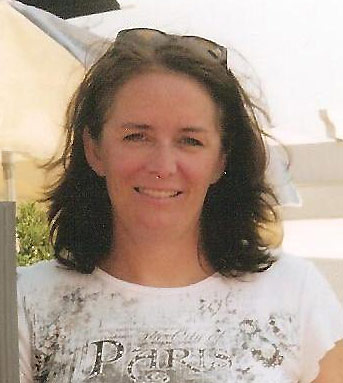
Known by her students as Mrs. Fisher or Doc Fisher, Sue is an archaeologist, educator, and mom. Sue’s love of Ancient Greece actually began in a 9th grade honor’s English class with the reading of Mary Renault’s The King Must Die. Sue started pursuing her goal of becoming an archaeologist at Franklin and Marshall College where she earned a B.A. in Greek, with a minor in anthropology.
Sue spent her junior year at College Year in Athens where she traveled extensively throughout Greece and studied Ancient Greek, Modern Greek, Greek Art and Archaeology and Greek Anthropology all in their original settings. During this year she also worked in the Athenian Agora inventorying and cataloguing ancient architecture and sculpture.
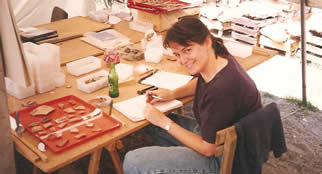 Sue began her graduate work in Bronze Age archaeology, excavating at the Mycenaean citadel of Midea, where she recovered the first Linear B ever found at the site. After receiving her M.A., however, Sue transferred to Classical Archaeology for her Ph.D. because she missed being able to use Ancient Greek language in her research. Ancient language was never far away, however, for while at the University of Cincinnati Sue taught Greek, Latin and Classical Civilization. While working at Midea, Sue prepared excavation reports, sorted lots of Bronze Age pottery and catalogued and published the Mycenaean pictorial pottery from the Lower Terraces at the citadel.
Sue began her graduate work in Bronze Age archaeology, excavating at the Mycenaean citadel of Midea, where she recovered the first Linear B ever found at the site. After receiving her M.A., however, Sue transferred to Classical Archaeology for her Ph.D. because she missed being able to use Ancient Greek language in her research. Ancient language was never far away, however, for while at the University of Cincinnati Sue taught Greek, Latin and Classical Civilization. While working at Midea, Sue prepared excavation reports, sorted lots of Bronze Age pottery and catalogued and published the Mycenaean pictorial pottery from the Lower Terraces at the citadel.
Sue also spent a few summers excavating at the site of Homer’s Troy in Turkey. Here she excavated and helped establish the pottery sequence and cultural profile of the Archaic period at the site. Both her work on the Mycenaean pictorial pottery and the Archaic finewares of Troy were presented to the Archaeological Institute of America at their annual meetings. Sue has also presented before the Central Ohio Valley Archaeological Society, the Institute for Learning in Retirement and various schools around the Cincinnati area, where she lives with her husband, two sons and two psychotic cats.
Degrees:
- B.A. Greek (Franklin and Marshall College, Lancaster, PA – Phi Beta Kappa, Magna Cum Laude, Archaeology Prize and Shirley Watkins Steinman Prize for Greek); B.A. Honors Thesis: The Attic Black-Figure Dancer: Iconography and Iconology.
- M.A. Bronze Age Archaeology (University of Cincinnati); Masters Thesis: Intra-Argolid “Regionalism” and the Mycenaean Pictorial Pottery from the Lower Terraces of the Citadel of Midea.
- Ph.D. Classical Archaeology (University of Cincinnati); Doctoral Dissertation: Ceramics and Culture: The Archaic Finewares of Ilion.
Teaching:
- Instructor for Latin 101 at the University of Cincinnati
- Instructor for Latin at Miami Valley Christian Academy
- Instructor for Greek 105 at the University of Cincinnati Greek
- tutor at Franklin and Marshall College
- Instructor for Classical Civilization at the University of Cincinnati
- Graduate teaching assistant for Art and Archaeology of the Ancient World at the University of Cincinnati
Professional Publications
- “The Mycenaean Pictorial Pottery,” in Midea: The Megaron Complex and Shrine Area. Excavations on the Lower Terraces 1994-1997 by Gisela Walberg (Stockholm, 2007).
- “The Mycenaean Pictorial Pottery,” in Excavations on the Acropolis of Midea. Results of the Greek-Swedish Excavations Vol. 1.1. The Excavations on the Lower Terraces 1985-1991 by Gisela Walberg (Stockholm, 1998).
- “Trojan G2-3 Ware Revisited,” in Studia Troica 6 (1996) 119-32 “A Pictorial Stirrup Jar from the Mycenaean Citadel of Midea,” (co-author) in Journal of Prehistoric Religion VIII (1994) 8-19.

